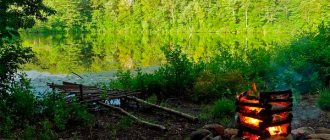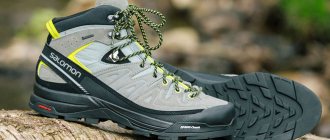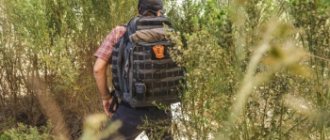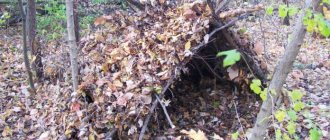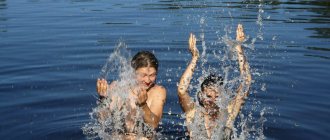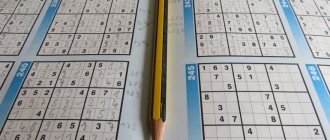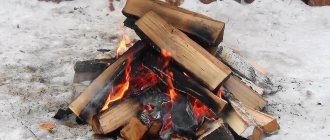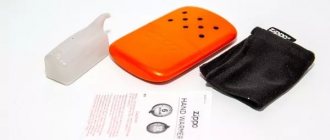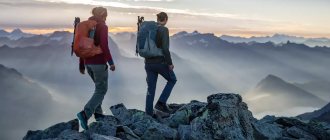New low-cost airline from S7: what is known about it?
Read July 27, 2021
Now it’s certain: Hungary has opened to vaccinated Russians
Read July 26, 2021
They want to confiscate foreign passports from debtors when they leave
Read July 23, 2021
Quarantine without isolation: countries that are opening to tourists
Read July 22, 2021
Greece takes on unvaccinated tourists
Read July 15, 2021
Transfer without transfer: why such tickets appear and what to do with them
Read
The unclear situation with the pandemic, borders and tickets continues, but you still need to travel and spend your vacation. There are many beautiful places around, investments are kept to a minimum, and the tent is not a hotel, there are no other guests in it. Considering that we've been going back and forth from the computer to the refrigerator for the past few months, it definitely couldn't hurt to shake things up.
Walk against stress and depression
People complain en masse about poor morale, depression and blues. And travelers also suffer from the inability to go somewhere or even just plan something in advance. Even those who take tickets abroad do so at their own peril and risk and with endless doubts. We urgently need to look for a solution.
psychologist, consultant in the method of positive psychotherapy, organizer of tourist groups of self-knowledge in Nepal
Danila Bezmenov
Research shows that even short walks in nature can reduce levels of the stress hormone cortisol, reduce symptoms of depression and anxiety, and, as a result, restore cognitive abilities and lift your mood. Long-term hikes, especially if you do not abuse gadgets in the evening, help restore the circadian rhythm by normalizing the production of serotonin and melatonin. Serotonin, in particular, is responsible for feelings of calm, focus and good mood. And melatonin regulates our sleep.
In addition, changing the environment and type of activity for a longer period allows us to take time for ourselves and pay attention to those things to which we, as a rule, are not attentive enough. In the modern world, we often have to play some socially acceptable or expected role. And the hike gives us the opportunity to be ourselves and express ourselves in a way that is comfortable for us. In a way, meet yourself. There you can feel the difference between your usual way of existence and look at your life from the outside, listen to what you really like and what you would like to get rid of. This experience of self-exploration and recharging the body’s resources allows you to calibrate your own life and get more pleasure and joy from it.
Games for schoolchildren on a hike
Outdoor camping games for schoolchildren
Author: Galina Vladimirovna Kostyrina, additional education teacher at the MBOU Center for Children's Creativity in the village of Karagaylinsky. Purpose: This development may be useful to preschool teachers and additional education teachers, and parents. Summer is a time for active recreation, country walks, hikes, picnics. Walking in the fresh air is very beneficial, especially for a growing child's body. The more time a child spends outside, the better, especially if children regularly go outdoors with their family or group. Often adults don’t know what to do with their children while relaxing in nature, so when going on a picnic, it’s worth thinking in advance about what to do with the kids. I offer you several options for fun and active outdoor games for children. Give them the opportunity to run around, make noise and have fun!
Goal: To organize the comprehensive social, communicative and physical development of the child; developing ingenuity, perception and understanding of the natural world through play. Objectives: • Expand children's ideas and knowledge about nature. • The ability to behave correctly in communication with nature. • Develop the emotional sphere of children through artistic and sound perception of nature. • Improve spatial orientation skills. “Whose jump is next?” The competition is held between teams (2 or more people). Task: the first team member performs a standing long jump from the intended line, the next player follows in his footsteps and jumps further, etc. The team with the longest collective jump wins.
"Who's faster?" Children are divided into two teams (2 or more people). For each team, a distinctive sign is chosen. (Ribbons of different colors, candy wrappers, bottle caps, etc.) Identification marks of each team are placed interspersed along the entire route (on trees, bushes, stones, etc.) Task: arrive at the designated location as quickly as possible , having collected their decals towards the finish line. The team that collects the most signs and reaches the finish line first wins. “The most observant” An adult hides an object (a flag, a baseball cap, a bag of chips, etc.) in the forest in a limited, clearly visible area. Names one or two signs indicating its location (forked birch tree, stump, etc.) Task: use the named signs to find a hidden object. The one who finds the item first is awarded the title “Best Pathfinder”.
“Dashes” The cardinal directions are determined by the compass and are marked along the edges of the clearing with bright objects (cap, scarf, ball, T-shirt, etc.) Task: children gather in the center of the clearing and at the signal “East”, “South”, etc. players must reach the designated location as quickly as possible. The player who makes a mistake is eliminated from the game. The game lasts until the two fastest and most attentive remain. “Don’t fold” Children are divided into two teams (2 or more people). Each team is given two code words indicating “you’re going right” - blue, “you’re going wrong” - red. Teams are placed on opposite edges of the clearing. Assignment: Each participant takes turns, blindfolded, and goes over to the enemy’s side. The team guides him with code words. The team that gets there faster and more accurately wins. “Pathfinders” Two players move away, under the supervision of an adult, deep into the forest, leaving behind pre-agreed small objects (cubes, corks, cones, ribbons, etc.), with the help of adults they disguise themselves there. Assignment: the children remaining in the clearing need to find their hidden comrades. “Find and remember” On a route 200 meters long, 7-9 object pictures (book, ball, animals, plants, etc.) are located at the same distance. Task: participants in the game start one at a time with an interval of 3 minutes. The winner is the one who covers the route in the shortest period of time and names all the objects shown in the pictures. I wish you a pleasant and fun time!
We recommend watching:
Scenario of literary and entertainment leisure in a school summer camp Program of a specialized shift in a school camp Scenario of a music and sports festival in an elementary school Scenario of a hike for students in grades 6 - 7
Similar articles:
Instructions for labor protection during walks, hikes, excursions, expeditions with schoolchildren
Stories for schoolchildren. Stories about summer
Games for children's camp
Opening shift. Scenario
Planning a camp shift
Choosing a place
One day hike
Hiking does not necessarily mean conquering mountain peaks, fording rivers and eating stew for breakfast, lunch and dinner. You can get out into nature for 1–2 days. With maximum comfort and a minimum of preparation, things, food and money.
But you still need to think through the route taking into account your physical shape, understand how to get there, and decide what things you will have to buy.
Where to go
There are many options - from the nearest forest to short, easy mountain trails. If you want to go deeper into the wild, but have no experience, find a suitable tour with a guide. Flying halfway across the country to complete a one-day route is probably not worth it. Although some adventurers will not agree with me. Choose places that can be reached within an hour or two by car, bus or train.
Natural parks, reserves, wildlife sanctuaries, and just forests near the city are great for your first short hikes. You can walk purposefully to some interesting object - an old manor, an abandoned hydroelectric power station, a waterfall. For example, not far from Moscow it is interesting to visit the Prioksko-Terrasny Nature Reserve or the Nikola-Lenivets art park.
What to take:
- documentation;
- tourist backpack 20–25 liters;
- comfortable sneakers;
- a raincoat or waterproof windbreaker (even if the sky is sunny);
- something on the head;
- sun protection (cream, light clothing with long sleeves);
- flashlight;
- snack, water;
- jackknife;
- hygiene products (wipes, hand sanitizer);
- first aid kit
Hiking with an overnight stay at a hotel or campsite
Another easy type of hike. You come to some beautiful location and stay at a hotel, campsite, or recreation center. Here you have nature all around and “civilization” - shower, kitchen, internet.
You can plan your route so that you constantly move forward and stop at different hotels/campsites. But then you will have to carry more things. Or you can stay in one place and go on radial hikes every day not far from the “base”.
Where to go
Choose popular areas with developed infrastructure: those very hotels and tourist centers and the entrances to them. There are many easy walking routes in the vicinity of Sochi and Krasnaya Polyana, in Arkhyz, and the Elbrus region. It's summer now, so you can combine a trip to the sea with a one-day hike in the mountains.
What to take:
- everything that you usually take with you on a trip - documents, a change of linen calculated for the number of days, a towel, rubber slippers for showering;
- tourist backpack 20–25 liters;
- sleeping bag (if the campsite has only a house, without amenities);
- trekking boots or comfortable sneakers;
- a raincoat or waterproof windbreaker (even if the sky is sunny);
- something on the head;
- sun protection (cream, light clothing with long sleeves);
- flashlight;
- snack (or a full meal, depending on the hotel/campsite), water;
- jackknife;
- hygiene products (wipes, hand sanitizer);
- first aid kit
have been walking under a backpack since 2007
Julia and Zheka Talalay
Never go on a hike, even the shortest one, in new, unworn shoes (the minimum period of wear before the hike is 2-3 weeks). It is very important that the shoes are comfortable and convenient: no flip-flops, sandals, sandals, sneakers (although we have friends who comfortably conquered the whole Crimea in sneakers). If you choose trekking boots, bring woolen socks to try on and be sure to walk around the store or shopping center for half an hour or an hour in them. This will help avoid calluses and keep your nails intact.
If there is water on the way (rivers, streams, fords), put aqua shoes or silicone sea slippers in your backpack. And it’s convenient to walk around the camp in shoes with thick foam soles, preferably without laces and unnecessary tightening, so as not to hang around for 10 minutes at the entrance to the tent.
Don't spare space in your backpack for a regular oilskin raincoat that folds up like a robe. The best option is a raincoat with a pocket for a backpack. Sure, modern backpacks come with great rain gear, but when it rains for a long time (a very long time), the water just runs down your back and you're wet.
Multi-day camping trip
For such trips you need general physical training, more money and at least one or two tourists with experience. You need to learn how to read a map, follow the markers, navigate the trails, find sources of water, distribute food and energy for the entire hike. If you don’t have experienced friends to fall on your tail, look for a tourist club in your city or in the place where you are going to go. A good club will have an active forum or group on social networks, many reports, photos, reviews.
Hikes vary in difficulty, and it is not at all necessary to immediately climb Elbrus. But even on a simple multi-day hike you need to sleep in a tent, cook over a fire and carry everything you need on yourself. You may be caught in the rain, you may lose your route, and your feet may get sore in the end. Therefore, you need to prepare and plan everything more carefully: decide on the route and number of walking days, calculate the amount of food, create a menu for all days, don’t forget anything, because there will be nowhere to get what you forgot. On the other hand, you need to take only what you need, because every extra gram is felt on your back.
But the reward for the inconvenience will be stunning views, sunsets and sunrises in the wild, places where most people never get to, complete relaxation and a break from civilization.
have been walking under a backpack since 2007
Julia and Zheka Talalay
When collecting things, the main reference point is the list. My husband and I use this trick: a couple of weeks before the trip, we choose a larger cardboard box and place it in the corner of the room. Remembering some necessary thing, we throw it into the box, and thus, by the time of the hike, everything essential will already be collected.
At the beginning of our hiking career there was a curious incident. A friend had a large, no, just a huge, heavy backpack. On the way out, no one, of course, checked this backpack, and throughout the hike we joked about its contents. A couple of days later a pillow was found there, like a sofa pillow, I don’t know the composition of the filler, but it was incredibly heavy. So comfort is comfort, but if you can’t do without a pillow, then let it be inflatable.
Where to go
For your first trips, choose locations that are easy for you to reach. Here are just some of the huge number of places available to beginners or those who rarely go out of town: Arkhyz, Altai, Southern Urals, Karelia, Crimea, Ergaki Natural Park in the Krasnoyarsk Territory. If you have time and a sense of adventure, you can follow the “legendary thirty” - tourist route No. 30 “Through the mountains to the sea.” The main thing is to first check if there are any restrictions on tourism in those areas.
What to take
For such a hike you will need a large backpack, a good sleeping bag, and comfortable shoes. Here is the list I use when going hiking. You can take it as a basis and adjust it depending on your habits and conditions.
If you are going on a tour, the organizers will provide a ready-made list for a specific route.
have been walking under a backpack since 2007
Julia and Zheka Talalay
Yulia: Comfort is very important to me, and it is provided by warmth. Don't skimp on your sleeping bag. Consider the night temperatures of the region where you are going hiking, and take a sleeping bag with a small margin of comfort temperature.
Zheka: Modern tourists, for the most part, use two types of backpacks: hard - frame, and soft - frameless. A distinctive feature of hard backpacks is their metal frame. Hence their biggest drawback, besides the high price, is their weight. Otherwise they are the most convenient.
There are also soft backpacks - frameless ones. Here they are cheaper. When packed correctly, despite all its disadvantages, the backpack is very comfortable. And many experienced tourists, especially those who go on difficult high-altitude hikes, use soft backpacks. Matter of habit. To choose the right backpack that suits you, you need to try on different options in the store.
General tips and safety
- The hike should be appropriate for your fitness level. It's better to start small than to ruin your vacation. Read reviews about the difficulty of the route and reports from other tourists. Assess your condition during long walks around the city or on a treadmill. Choose a distance slightly shorter than what you would walk on a flat, paved road. Be aware of possible ups and downs along the way. And keep a moderate pace so as not to burn out on the first day.
- For a multi-day backpacking trip, start preparing at least a month before going out. Walking with a weight of 25-30 kg throughout the day is a good test of endurance. The paradox is that for the first few days, when the body is just getting used to the stress, you have to carry the heaviest backpack. Then the reserves are slowly eaten up.
- Check the weather. The forecast is subject to change, so the last check is just before leaving. Once, Yulia, Zheka and I went for a day to Zuevka to look at the burning stones - the place where methane escapes to the surface. On the way back we were hit by a sudden downpour. We were saved only by some local bus, which miraculously turned up on the road, picked us up and took us to the nearest bus station. And a bottle of rum, drunk later on the road from Khartsyzsk to Donetsk.
- Shoes and clothing should be as comfortable as possible. And only then (or never) - beautiful. Choose clothes made from synthetic fabrics or wool. It is lightweight, absorbs moisture well and dries quickly.
- In addition to the main food, take snacks with you - jerky, mixed nuts, dried fruits, candies, chocolate and grain bars. They will be a great snack on the way between stops.
- Remember safety. Leave your family your route and contact details of the people you are going on a hike with. Stock up on telephone numbers of local rescuers in advance (there may not be internet). Again, due to the fact that communication does not work everywhere, agree with your family how often you will write/call each other. Let them know that you won't be able to be on call all the time.
- It’s probably not worth reminding, but still. Don’t forget about the unspoken camping etiquette: be friendly and polite, respect other people and wildlife, don’t make noise, and pick up trash after yourself. We must keep clean all the beautiful places that the world gives us.
Useful tips while hiking
Socks and a cap, keep everything warm, so to speak. This post is dedicated to a selection of simple tips (let’s call them “little things”, from the saying “a little thing is nice”). Little things like this can become a serious argument when solving various issues, and it doesn’t hurt to just know them. You can always add useful advice in the comments, and when you have a large collection of little things, you can make a second, third, and so on notes. So, here are some useful tips for your hike:
- — Walking inside a tent with shoes is taboo. It should always be left outside when you enter the tent. For better preservation (to avoid moisture, dust, unnecessary insects), it is better to hide shoes at night in a light fabric bag.
- — In a company of three or more people, it is better to make two small fires than one large one.
- — Remember that a rope is one of a tourist’s best companions and should always be in your pocket. One of its important uses is that you can collect firewood without an ax or saw. By tying a hook or other strong piece of wood to one end, you can hook low branches with it and break them off (but DO NOT BREAK LIVING BRANCHES!). Or the simplest thing is to collect a large pile of brushwood and other firewood, tie them into a bundle and bring it to the camp.
- — fire should be located away from the tent so that an accidental wind does not carry sparks or scorch the awning.
- — Do not take liquid fuel on a hike; a backpack soaked in such liquids is unsuitable for further use. And what can spill will spill, and what can wake up will wake up.
- - Make in advance for each participant (or tell them to do so) a spare box of matches insulated from external conditions. This way you will be reliably protected from the trouble of wet matches, and there will be backup options if someone’s spare is lost or damaged. Use in case of emergency. Save regular matches too.
- — To satisfy different tastes and a limited number of thermoses, boil water and pour it into a thermos. Boiling water will come in handy at a stop/lunch and can satisfy several people who want to drink tea, coffee or brew noodles at once.
- - At a convenient parking lot, choose a time and make a light for the fire - collect wood chips, pieces of bark, moss, thin twigs, mix with pieces of paper, pieces of cotton wool, dry leaves and grass and make several light-up bags slightly smaller than a fist, wrapped in paper. Isolate them from the external environment and distribute them in backpacks to participants. At the next parking lot, you will probably have no time to look for dry firewood in the pouring rain or something else terrible =) And such a bag will make it easier to start a fire and, even if not on the first try, will dry out the wet branches. And in general it will be useful.
- - Nowadays it’s not difficult to find small folding shovels for tourists - be sure to buy one for yourself. It is still more convenient to dig a tent, cut down steps, and fence off a fire pit with it than with a knife, an ax or your hands.
- — If you don’t have a frying pan, then an ordinary can of stew can provide some kind of alternative.
 And with a lid
And with a lid - — Try to dress in bright clothes, use bright, poisonous colored covers for objects.
 Plain objects (handles of axes, knives and the like) can be painted with bright striped or solid colors. This will make it easier to find them
Plain objects (handles of axes, knives and the like) can be painted with bright striped or solid colors. This will make it easier to find them - — clothing attracts mosquitoes less. The color of clothing does not affect other harmful insects.
- — If you don’t have a headdress, you can tie a T-shirt on your head. And it won’t hurt your neck and looks like a bondan.
- - Advice for kayakers: if according to your navigation it turns out that you are likely to stand in a meadow where there is little vegetation, then it is better to find in advance two thin, dry tree trunks, slightly thicker than a shoulder. Tie them to the canoe and you have a supply of firewood.
- — Do not rush to use repellents on yourself, no matter what is advertised, chemicals are contraindicated not only for insects, but also for you. Try to use spirals around the camp and ward off hordes of bloodsuckers by throwing greens into the fire. Place wormwood or quinoa, elderberry or wheatgrass in the tent; when you go to bed, throw the plants into the vestibule. And remember about allergies, both to grass and to chemicals.
- - What else scares Komarov’s spawn? Aroma of clove, basil, eucalyptus and anise, tobacco smoke and valerian.
- “ the bream, they burn it.”
- - no particular need to rush straight into dense thickets of bushes and forests. Look for more convenient entrances.
- - Forget about shorts. Get burned, get ticks, get bitten by “flyers”, chapped your skin.
- - Everyone should have their own folding knife, or sheath.
- - Get ready in the evening, it’s extremely lazy to do it in the morning, and leave only the essentials for the morning.
- — Each person should have their own personal flashlight and a set of batteries for them.
- - fork is a spoon. Do not take forks (unless it is in a universal knife-fork-spoon set).
- — Divide the things in your backpack into separate packages. Always fold it carefully immediately after climbing down.
- - Return things to where you got them from. When you put things in a tent or nearby, loudly tell everyone what you are putting where (but only if there are three or four of you; it is useless to shout in groups, so just put it back where you took it from).
- - If the label fell off the tin can or they all got wet and all the labels slipped off, it doesn’t matter... The markings will help you determine what’s inside: the letter “P” means canned fish, “K” means vegetables, “M” means meat and dairy. Or you can sign it in advance with a disc marker.
- — When packing a backpack, do not forget the “vector” of packing: the closer to the back, the softer, the lower, the more rarely you get things.
- — If you take spare clothes (in most cases, but there are exceptions), then keep in mind that they are temporary and give you time to dry and repair your main clothes. At worst, don't walk around naked.
- - Try to find some potassium permanganate. It may happen that you have to disinfect the water because the supply has run out/lost.
- — Take a couple of candles, who knows when your electricity will run out, but you will need light. You are unlikely to use them, but one or two won’t hurt.
- — Writing down travel notes is very useful. After the hike, they will allow you to preserve memories of the hike much more accurately, comprehensively and fully and prevent many troubles in the future.
- - Always discuss discipline. Wake up, breakfast, travel time, lunch, rest, dinner, lights out. Distribute responsibilities or take on something specific.
- - local residents in one case - if you are in trouble. Otherwise, avoid them.
- — Take some thick aluminum wire. It’s not heavy and will always come in handy for pot hooks, for strengthening and fastenings, you never know! Ho-ho!
- — Wash the dishes immediately after eating, and everyone does their own. The chosen one washes the common one.
- — To help the chosen one: grab a steel dishwasher.
- - Watch each other - a tick removed in time, unburnt skin, and other moments are a good reason to rejoice.
- - Sunglasses are a cool thing!
- - You can make herbal tea: fragrant mint (pepper, forest, green) - 1 part, oregano - 2 parts, black currant leaves - 6 parts, meadowsweet flowers (or sweet clover, or thyme) - 0.5 parts. Coarsely chop the herbs and add 1 teaspoon per 0.5 liter of boiling water.
- — By the way, it’s convenient to take a brewing strainer with you.
- — Dry your shoes by the fire. During the hike, she becomes damp from sweat.
- - Well , if the ants nevertheless attack you, and the camp is thoroughly laid out, you will have to make one or three traps for them.
 Make a sweet syrup (if you have jam, then use it) and pour it into a container (preferably a glass jar, but canned ones are also possible), and place traps not far from the ants’ path, and if there are very, very, very many of them (such as on "Anthill", which is at the Leather cordon, near Voronezh), then along the perimeter of the camp and God forbid you drop them
Make a sweet syrup (if you have jam, then use it) and pour it into a container (preferably a glass jar, but canned ones are also possible), and place traps not far from the ants’ path, and if there are very, very, very many of them (such as on "Anthill", which is at the Leather cordon, near Voronezh), then along the perimeter of the camp and God forbid you drop them - - Save the water. If there is a stream/river/lake nearby, then the entire supply of water automatically becomes potable and is used extremely sparingly.
- — P reserves are one of the best hermetic bags and are convenient for carrying water.
 Well, of course, the grease needs to be washed off.
Well, of course, the grease needs to be washed off. - — n’t hurt to grab a few screws/nails. In long-term or convenient parking, you can organize a table if possible. After you leave, the people who came after you will thank you. Well, or they will break it, no one has canceled assholes.
- - Don't try to burn all your wood. Bury the rest so that they do not get wet if possible. A supply of logs or brushwood that comes after you will greatly facilitate an overnight stay or a day. By the way, if you come across a truly cache with a supply of canned food, firewood and other things, then update it (if possible). If his canned food is good, take it for yourself, and leave fresher ones in return. Either don’t touch the firewood or replace it when you leave. It was made on purpose, and who knows who it will save.
- — Think about the cultural part of the trip. Cards are not the only way to have fun.
This is where the first entry of trifles ends, I will prepare a new one. I hope you find them useful. And if you know them all, then it’s not a bad idea to refresh your memory. Hi all!
The second part of trifles
Guard: If you are in Ukraine, then you will need the opportunity to rent apartments for daily rent in Kiev.
Think in advance about where to live in this beautiful city while you are visiting here! Save for later:
